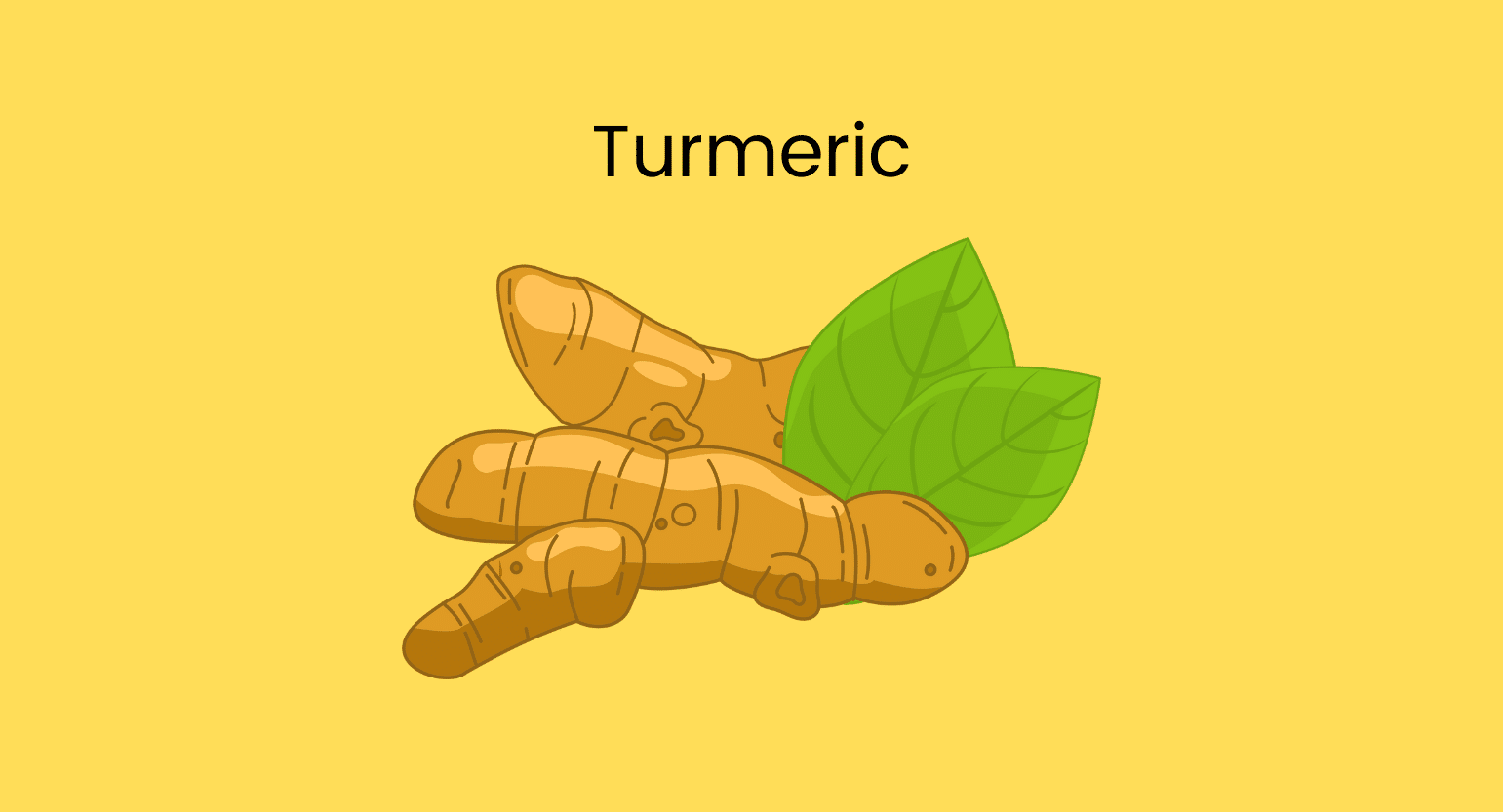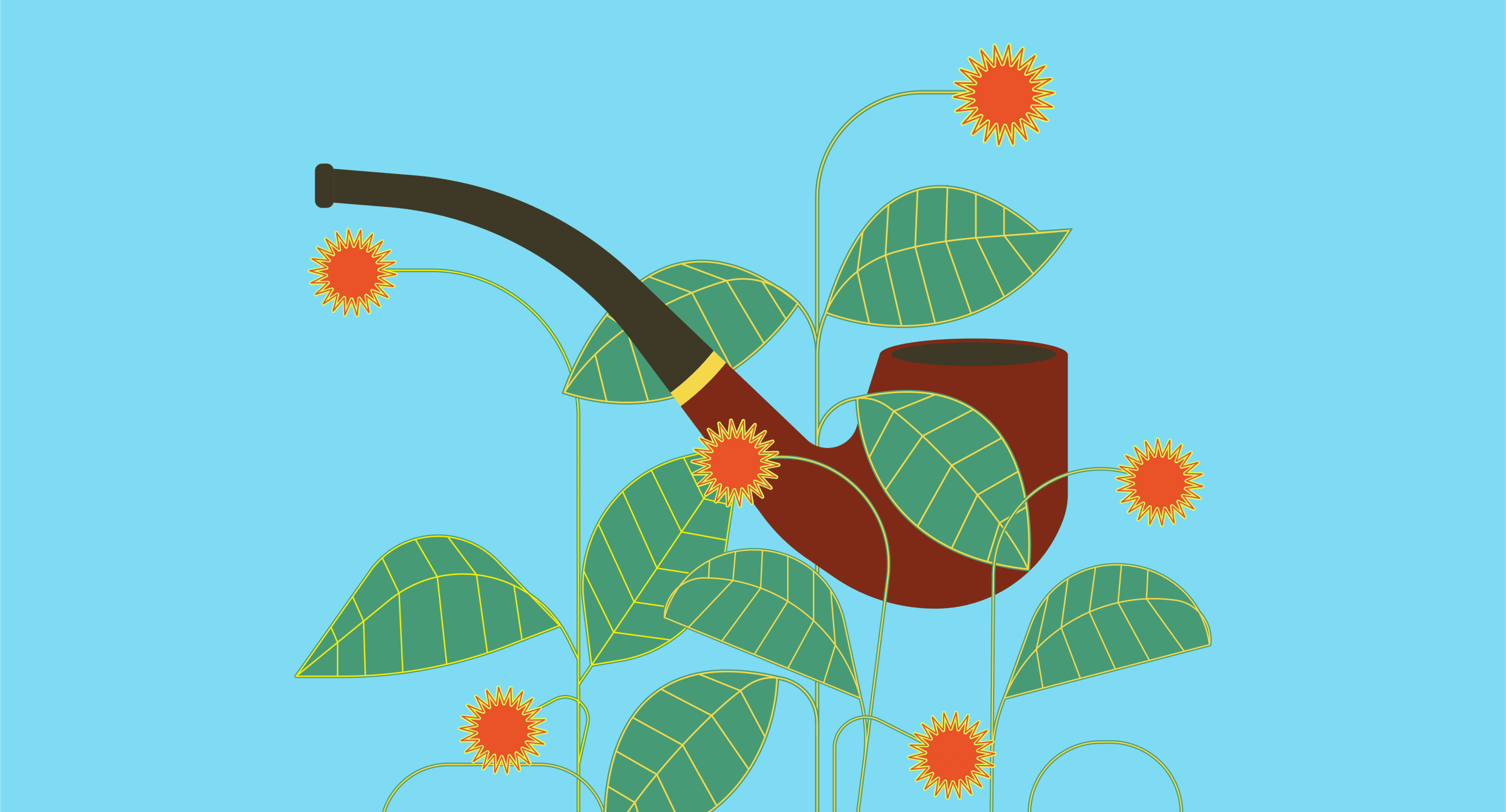People combine turmeric with kratom mainly because it makes the kratom stretch further — meaning it takes less to induce the same effects.
This unusual combination appears safe, but don’t combine them regularly. Turmeric is a commonly-used Asian spice, and there are very few risks associated with its consumption. In fact, curcumin — a major compound in turmeric — may have several health benefits, as some studies suggest [1].
In this article, we’ll look at:
- How turmeric interacts with kratom
- The effects the combination induces
- Whether it’s safe to mix the two substances
- What turmeric is, its uses, and side effects
- What kratom is, how it’s used, and its effects
- The different kinds of kratom leaf
I’ll also be answering a few frequently asked questions about kratom.
Does Kratom Interact With Turmeric?
Yes, kratom and turmeric interact with each other. Turmeric seems to increase the bioactivity of kratom — a phenomenon known as “potentiation.” However, it’s important to note that, as of yet, no scientific evidence proves exactly how these two substances work together.
Turmeric is essentially a metabolic competitor, meaning it competes for metabolism by the liver. Kratom begins to take effect when the CYP3A4, CYP2D6, and CYP2C9 enzymes in the liver begin metabolizing its active compounds, including mitragynine — kratom’s primary alkaloid responsible for much of its effects — allowing them to be absorbed into the bloodstream [2].

It’s believed turmeric can increase and prolong the effects of kratom because curcumin and mitragynine are targeted by various cytochrome P450 (CYP) enzymes, including:
- CYP1A2
- CYP2C9
- CYP2C19
- CYP2D6
- CYP3A4
Ingesting turmeric alongside kratom powder helps slow the liver’s metabolic process because these enzymes have to work twice as hard. This “slowed elimination” of the active compounds in kratom means less powder goes further.
Many kratom users report needing around 25% less kratom powder when consuming it with turmeric directly or supplementing with turmeric capsules before ingestion.
Related: Exhaustive List of Kratom Drug Interactions
Kratom & Turmeric Interactions
Turmeric’s major alkaloid, curcumin, is a polyphenolic compound partly responsible for turmeric’s golden-yellow color. Polyphenols are a group of natural compounds with antioxidant properties and are commonly found in various plants, fruits, seeds, and grains across the globe.
Curcumin is directly responsible for potentiation when consumed with kratom. Most other polyphenols similarly interact with the body and are metabolized in the liver by the same enzymes. This could mean that other compounds in this class interact with kratom in the same way — increasing and prolonging the effects of the substance.
Polyphenols represent a diverse and exhaustive group of compounds present in various plants, fruits, nuts, and grains — many of which are edible.
Here are some other polyphenols that may interact with kratom:
- Quercetin: Onions, apples, berries, and leafy vegetables
- Epicatechin: Cocoa, dark chocolate, and green tea
- Kaempferol: Kale, broccoli, and tea
- Luteolin: Celery, peppers, and carrots
- Myricetin: Berries, grapes, and red wine
- Rutin: Citrus fruits, buckwheat, and asparagus
- Resveratrol: Grapes, red wine, and berries
- Pterostilbene: Blueberries, grapes, and almonds
- Gallic acid: Tea, grapes, and berries
- Caffeic acid: Coffee, fruits, and vegetables
- Ferulic acid: Whole grains, coffee, and vegetables
- Chlorogenic acid: Coffee, apples, and tomatoes
- Ellagic acid: Pomegranates, berries, and nuts
- Cyanidin: Berries, cherries, and red cabbage
- Delphinidin: Berries, grapes, and eggplant
- Procyanidins: Cocoa, apples, and red wine
- Genistein: Soybeans and legumes
- Daidzein: Soybeans and legumes
- Secoisolariciresinol: Flaxseeds, sesame seeds, and whole grains
It’s important to note that although these compounds are polyphenols, they may not produce the same or as strong potentiating effects as curcumin when consumed with kratom. Very few (if any) scientific studies assess the value of these polyphenic compounds when combined with kratom or its active alkaloids.
Is it Safe to Consume Kratom With Turmeric?
The safety of consuming turmeric with kratom has not been specifically studied, and there’s limited information available regarding their potential adverse interactions.
Both turmeric and kratom have their own effects and mechanisms of action — combining them may have unpredictable outcomes. However, based on the available knowledge about these substances individually and reports from people who consume them together, they are generally considered safe when used responsibly and in moderation.
Turmeric is a commonly-consumed spice with a long history of culinary use in Asian cooking and as a traditional medicine in various cultures across Asia — particularly those in South and Southeast Asia. Curcumin has also been widely studied for its antioxidant and anti-inflammatory effects [3].
Kratom, while controversial and subject to legal regulations in many countries, has been traditionally used medicinally in Southeast Asian cultures for centuries.
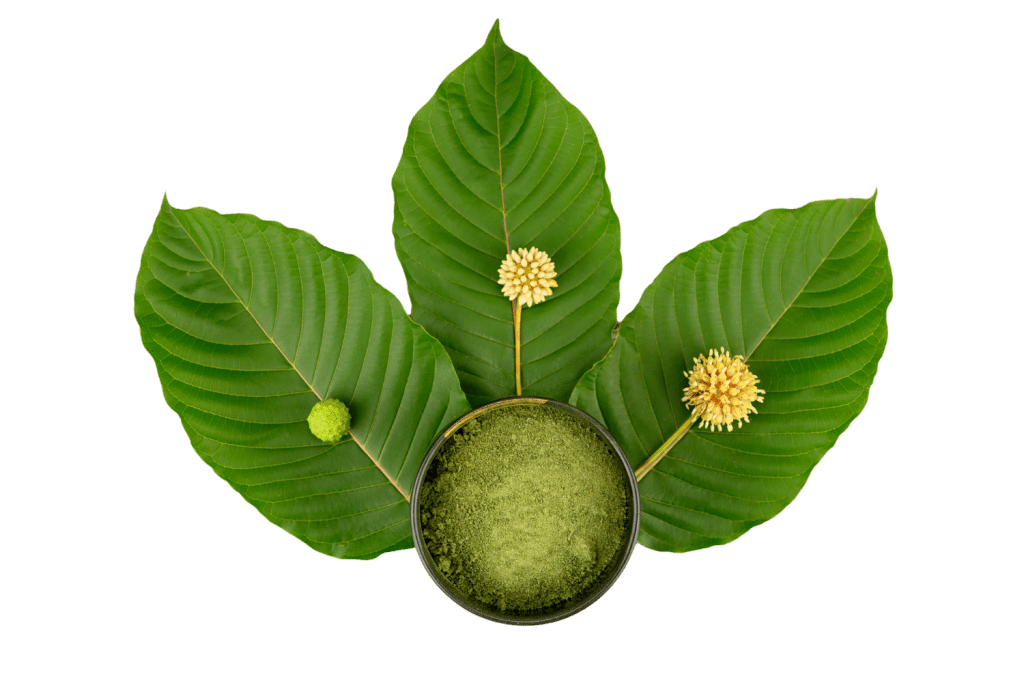
There is one concern when it comes to mixing kratom and turmeric, and that’s the fact that they are metabolic competitors.
Metabolic competitors slow the elimination of compounds in the liver. If turmeric and kratom are consumed together regularly, it could lead to a toxic buildup of both substances in the liver — this can cause complications over time and may lead to some health issues.
Consuming metabolic competitors regularly over a long period may decrease metabolism, lead to liver and kidney problems, or cause stomach ulcers.
If you are considering combining turmeric and kratom and have any concerns, it’s recommended to consult with a healthcare professional or pharmacist. They can provide personalized advice based on your circumstances and help you make informed decisions regarding their use.
Doctors can also consider any potential interactions or effects based on your health status and any medications you may be taking — it’s generally not advised to consume kratom (mixed with turmeric or not) alongside prescription medications.
What is Turmeric?
Turmeric is mainly known as a common spice used in Indian and Thai cooking. Often used as a powder, this aromatic is ground from the rhizomes of the Turmeric plant (Curcuma longa) — a perennial flowering plant in the same family as ginger (Zingiberaceae).
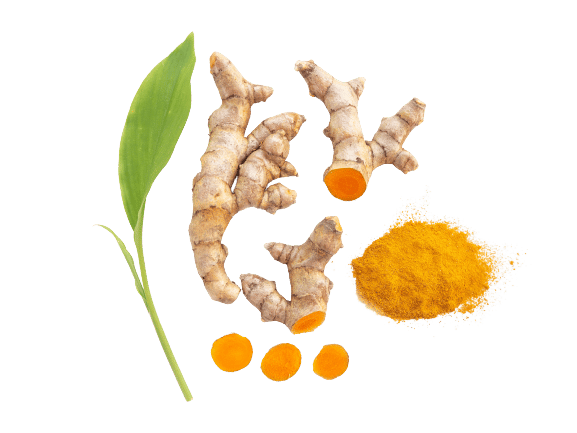
Turmeric has been used for thousands of years as a culinary spice, dye, and traditional medicine in various cultures, particularly in South and Southeast Asia. It’s a common ingredient in several dishes — the most prominent being curry — giving them their characteristic yellow color and warm, earthy flavors.
The main active compound in turmeric is curcumin, which is responsible for many of its health benefits and distinctive medicinal properties. Curcumin is a polyphenol with potent antioxidant and anti-inflammatory properties. It has been the subject of extensive scientific research due to its potential therapeutic effects on various health conditions.
Aside from curcumin, turmeric contains several other terpenes, essential oils, vitamins, and minerals that contribute to its nutritional profile, physical qualities, and flavor.
Taxonomy & Characteristics of Curcuma longa (Turmeric)
Taxonomy
- Kingdom: Plantae
- Phylum: Magnoliophyta
- Class: Liliopsida
- Order: Zingiberales
- Family: Zingiberaceae
- Genus: Curcuma
- Species: longa
Physical Characteristics
- Appearance: Turmeric is a herbaceous perennial plant that grows to around one meter (three feet) in height with a width of between 60 centimeters (two feet) to 90 centimeters (three feet) wide. It has large, green leaves with prominent midribs and sheathing leaf bases. The plant forms a thick, tuberous rhizome underground which can often be seen protruding at the base of the plant.
- Rhizomes: The rhizomes of turmeric are thick, fleshy, and segmented. They have dark brown outer skin and vibrant orange-yellow flesh inside. The rhizomes are the source of the turmeric spice. They have a distinct earthy aroma and a slightly bitter, warm taste.
- Flowers: Turmeric plants produce cone-shaped inflorescences known as spikes (flowers directly attached to the main stem without individual stalks). The flowers emerge from the center of the plant and consist of compact clusters of small, yellow flowers with purple-tinged bracts.
- Location: The Turmeric plant is believed to be native to the Indian subcontinent, specifically to the region encompassing India and Pakistan. However, the plant has been used for centuries and now grows wild in Southeast Asia, China, West Africa, Central & South America, and the Caribbean.
- Cultivation: Turmeric is primarily cultivated in tropical regions, thriving in warm and humid climates. It requires well-drained soil and regular watering. The plant is propagated by dividing the rhizomes, and it takes around 9-10 months for the plants to mature enough to a point where the rhizomes can be harvested.
Turmeric Details & Specifications
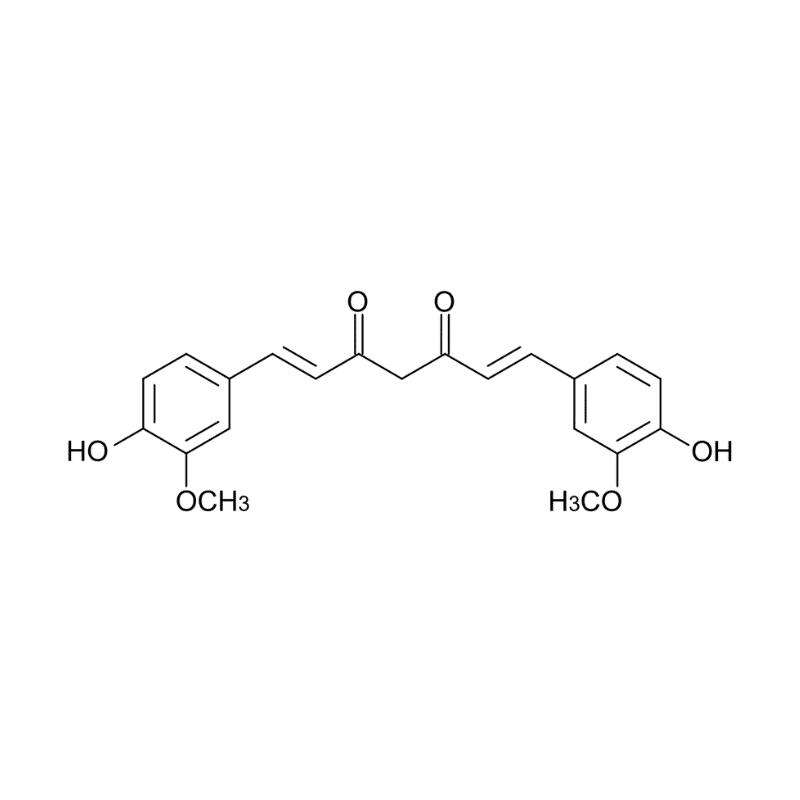
| Substance Name | Turmeric (Curcumin) |
| Other Names | Curcuma longa, Haldi, Indian Saffron, Jiang Huang, Kunyit, Ukon, Halad, Khamin Chan |
| Classification (Curcumin) | Curcuminoid Polyphenol |
| CYP Metabolism | Cytochrome P450 (CYP1A2, CYP2C9, CYP2C19, CYP2D6, CYP3A4 |
| Interaction with Kratom | Metabolic Competitor |
| Risk of Interaction | Low |
What is Turmeric Used for?
You’re probably most familiar with turmeric’s use as a culinary spice. However, turmeric has been used for various purposes throughout history.
Here are some common uses of turmeric:
1. Culinary Applications
Turmeric is widely used in cooking, especially in South Asian cuisine. It adds a warm, earthy flavor and the characteristic golden-yellow color that’s associated with several different curry dishes. Turmeric is a key component in many South and Southeast Asian curries, sauces, marinades, and rice dishes.
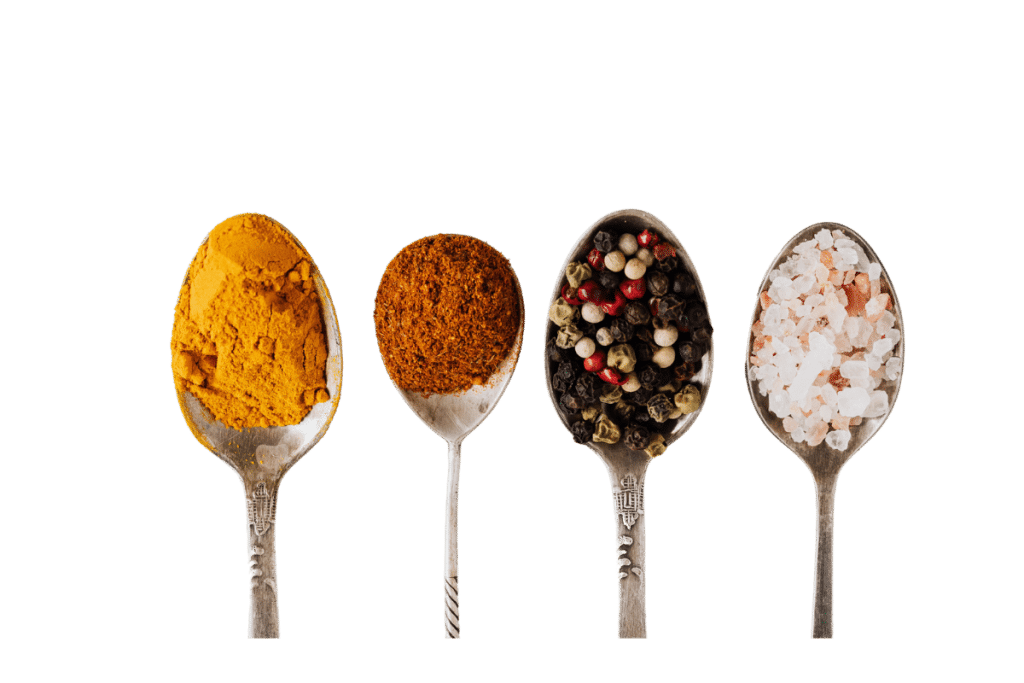
2. Fabric Dye
Traditionally, turmeric has been used as a dye to stain natural fibers a vibrant yellow. It’s not used commercially in the West, but it’s still used in the creation of traditional clothing in South Asia and by textile hobbyists across the globe.
3. Traditional Medicine
Turmeric has been used as a traditional medicine for centuries. Historically, it has been used to support digestion, liver health, and overall well-being. It has also been used topically for general skincare and treating breaks to the skin and other injuries.
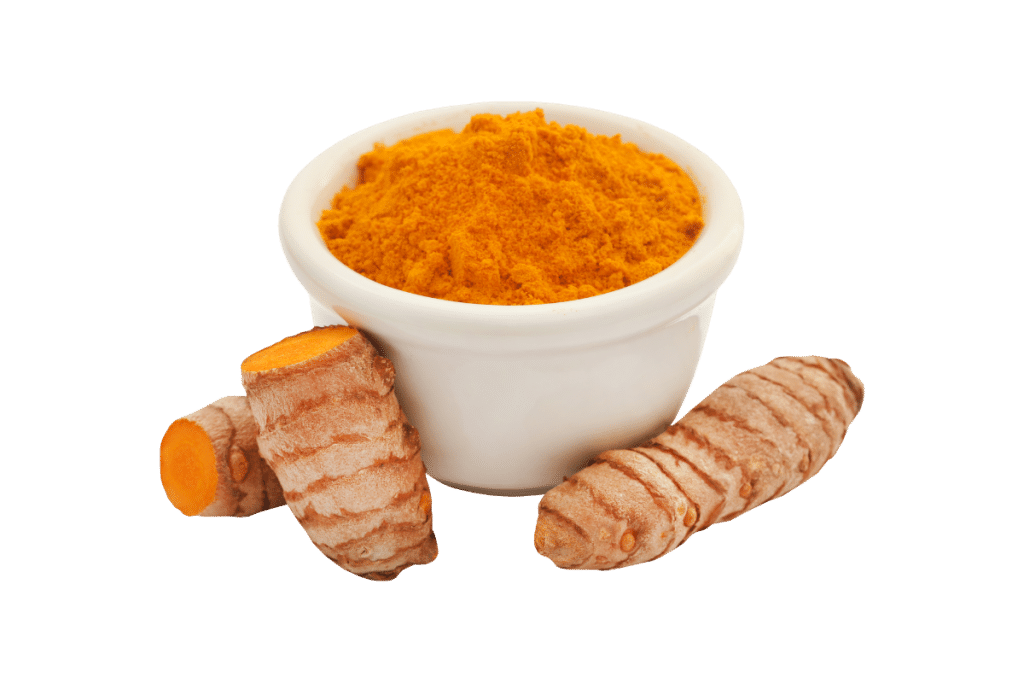
4. Anti-Inflammatory Benefits
Curcumin — the active alkaloid in turmeric — has potent anti-inflammatory effects. Some studies suggest that ingesting turmeric may help reduce inflammation and alleviate the symptoms of chronic inflammatory conditions such as arthritis [4]. Several people consume turmeric regularly for its anti-inflammatory response.
5. Antioxidant Benefits
Curcumin acts as an antioxidant. Antioxidants help protect cells from the damage caused by harmful molecules known as free radicals. Natural antioxidants such as curcumin reduce and delay cell damage by stabilizing free radicals [5]. Many people consume turmeric for its antioxidant properties.

6. Cultural & Ritual Uses
Turmeric holds cultural and religious significance in many societies across Asia. It’s used in religious ceremonies, festivals, and traditional rituals in India, Sri Lanka, Pakistan, and several Southeast Asian countries. In some cultures, turmeric paste is applied to the skin during weddings and other auspicious occasions to symbolize purification and prosperity.
What’s the Dose of Turmeric?
There’s no particular dose of turmeric. Although the plant may have medicinal properties, it’s not a “drug” in the same sense as other natural substances such as kratom, cannabis, or psilocybin mushrooms. However, there are some recommendations for consuming turmeric and curcumin extracts.
Turmeric for Culinary Use
In cooking, there’s no specific “dose” or amount that should or shouldn’t be used.
The spice is used according to personal preference and taste, but people usually add a teaspoon or two of powdered turmeric to a dish — more for multiple servings.
Turmeric for Supplementation
Turmeric is available in various forms. Supplements are available as capsules, tablets, and liquid extracts. The dosages of these supplements vary depending on the specific product. If you choose to supplement with turmeric, it’s important to follow the instructions and dosage guide provided by the manufacturer.
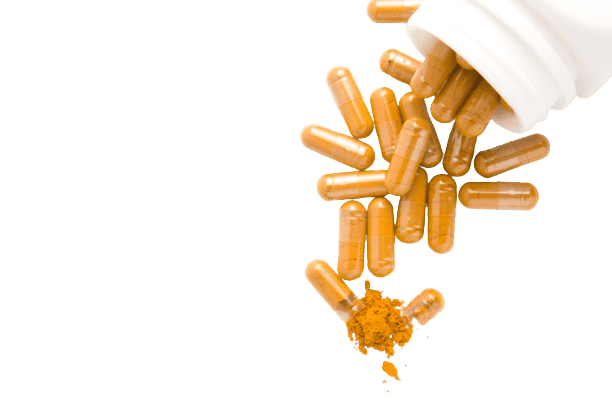
As a general guide, most people consume a daily dose of 500 to 1000 milligrams of turmeric extract containing 85% to 95% curcumin. This dose is often divided into three and consumed throughout the day (morning, midday, and evening). However, the dosage can differ depending on the individual’s needs and the conditions being addressed.
It’s worth noting that the absorption of curcumin in the body differs from person to person. Generally, the substance is poorly metabolized on its own, and many people believe its bioavailability improves when it’s taken alongside black pepper or a source of fat.
It’s best not to consume turmeric with a source of fat or black pepper if you want to use it to boost or prolong the effects of kratom.
Does Turmeric Have Any Other Names?
Turmeric has several names. Different countries and regions have different names for the plant — some of which you may have heard before.
Here are some commonly-used names for turmeric:
- Curcuma longa: This is the binomial (scientific Latin) name for the turmeric plant species.
- Jiang Huang: This is the Chinese name for turmeric. You’ll often see this name in traditional Chinese medicine and cooking.
- Indian Saffron: Turmeric is sometimes referred to as “Indian Saffron” due to its vibrant yellow/ orange color, which is similar to the much more expensive spice saffron.
- Haldi: This is the Hindi name for turmeric — it’s widely used to describe the plant and its resulting spice in India.
- Kunyit: This is the Indonesian name for turmeric.
- Ukon: This is the Japanese word to describe turmeric spice.
- Halad: This is the name for turmeric in the Philippines, particularly in the Tagalog language.
- Khamin Chan: This is the Thai word for turmeric.
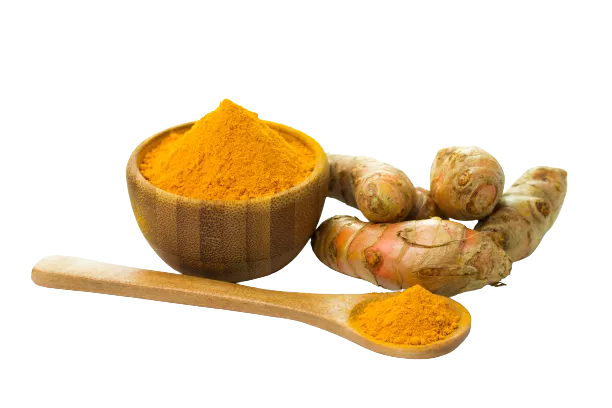
Are There Any Side Effects of Turmeric?
Turmeric is generally considered safe for culinary use. Unless you have a particular allergy to turmeric, you’ll unlikely experience any side effects after eating a dish containing it. When turmeric is used in cooking, it’s added in relatively small concentrations compared to the quantity of food on the plate.
Turmeric is also considered safe for use as a supplement in higher doses. However, there are some potential side effects and some considerations you should make before consuming large quantities of turmeric regularly. Some people may be more at risk of developing side effects compared to others.
Here are the potential side effects and ways turmeric may impact some people negatively:
1. Allergic Reactions
Some people may be allergic to turmeric. Those who suffer from the allergy may experience skin rashes and hives or more serious symptoms such as restricted airways. If you have allergies to related plants or are particularly sensitive, it may be best to avoid turmeric.
2. Stomach Discomfort
Turmeric stimulates gastric acid production, which can induce stomach discomfort in some people. Those with gastrointestinal conditions such as acid reflux or stomach ulcers may aggravate them through turmeric consumption.

3. Blood Thinning
Turmeric is a mild anticoagulant — meaning it thins the blood slightly. This can benefit some people, but it may increase the risk for people taking anticoagulants or antiplatelet medications. If you take blood-thinning medications, consult your doctor before consuming turmeric.
4. Interactions With Medication
Large quantities of turmeric may interact with certain prescription medications. It’s important to seek advice from your doctor if you are taking regular medications because turmeric may interfere with the drug’s effectiveness or increase the risk of side effects.

5. Gallbladder Issues
Turmeric stimulates bile production, which can worsen a pre-existing gallbladder issue. If you have a history of gallstones or have gallbladder disease, you should consult a healthcare professional before using turmeric.
6. Pregnancy & Breastfeeding
Although safe when consumed in culinary quantities (in curries and other meals), turmeric supplements are not recommended for pregnant women or those breastfeeding.

It’s important to note that individual responses to turmeric can vary. Some people are more susceptible to certain substances than others. If you have any concerns or specific health conditions, it’s always best to consult your doctor before consuming turmeric supplements or kratom.
What is Kratom?
Kratom is a substance derived from the Mitragyna speciosa tree, a tropical evergreen native to Southeast Asia, mainly Thailand, Indonesia, and Malaysia.

The kratom tree has glossy, dark green leaves with a smooth texture. The leaves contain various alkaloids, such as mitragynine and 7-hydroxymitragynine, which are responsible for the mild psychoactive effects.
Kratom powder, extracts, and teas are made from the dried leaves of the Mitragyna speciosa tree. There are several variants of this species that produce slight variations in chemical composition — giving different “strains” slightly altered effects.
What’s Kratom Used for?
Kratom is used for a variety of reasons. It can be used recreationally for its psychoactive effects. Users can experience stimulation, sedation, euphoria, and relaxation depending on the strain and dose of kratom consumed. However, kratom isn’t only used for its intoxicating effects.
Kratom is commonly used to help with the following:
- ADHD
- Anxiety
- Benzo withdrawal symptoms
- Chemotherapy-related pain
- Depression
- Energy & focus
- Fibromyalgia
- Insomnia
- Migraines
- Neuralgia (nerve pain)
- Opiate withdrawal symptoms
- Post-partum pain
- Weight loss
What’s the Dose of Kratom?
The dose of kratom differs depending on the effects you’re looking for, the condition you’re attempting to treat, or the symptoms you want to alleviate (if any).
Smaller doses are best for improving energy, mood, and focus, whereas larger amounts work better for alleviating pain and inducing sleep. Generally speaking, lighter doses are more stimulating, and heavier doses are more sedating. However, the strain plays a significant role in the effects you’ll experience.
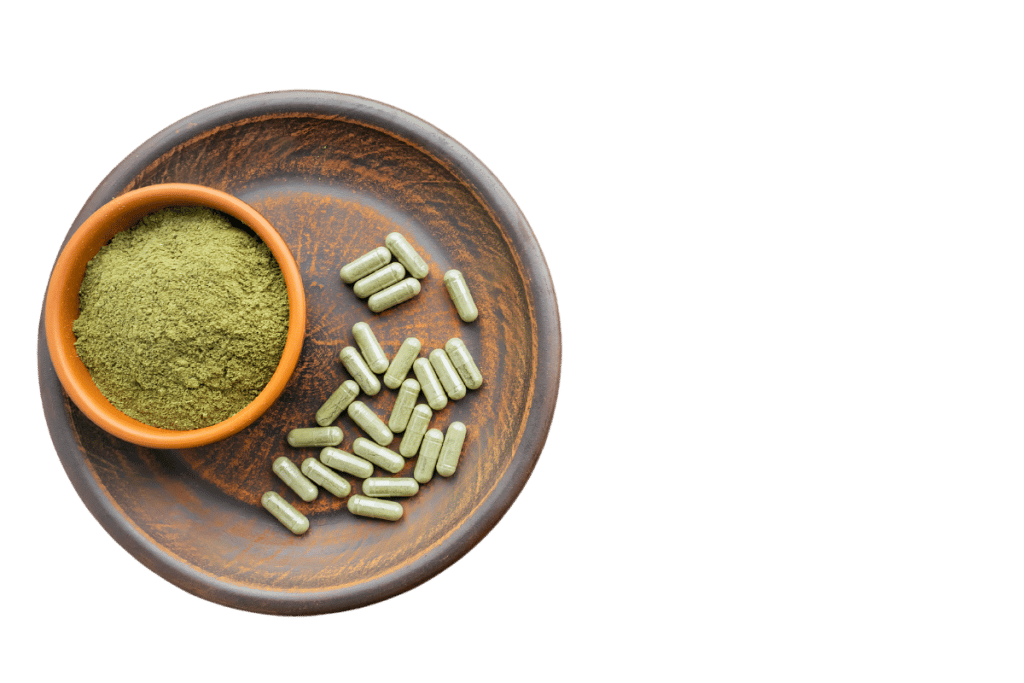
Several factors will alter the required kratom dose, such as body weight, metabolism, tolerance, and how full your stomach is.
Generally speaking, a good dose of kratom for beginners is around two grams. The dosage can be increased over time, but avoid frequent use to reduce the chances of developing an addiction or negative side effects. If you find you’re building a tolerance, a “tolerance break” can help you reduce your dose and avoid dependence.
The best way to find the right kratom dosage for you is to use a dosage calculator.
Related: Top 10 Kratom Alternatives
Are There Any Side Effects of Kratom Use?
If used responsibly, it’s unlikely that you’ll experience many side effects from kratom. However, everyone reacts differently, and you may experience side effects from doses that are too high, frequent usage, or substance mixing.
Here are some of the common side effects of kratom:
- Anxiety
- Changes in libido
- Constipation
- Dizziness
- Dry mouth
- Fatigue
- Headache
- Heart palpitations
- Increased urination
- Insomnia
- Irritability or mood swings
- Loss of appetite
- Nausea
- Sweating
- Tremors or shaky movements
What Are the Different Types of Kratom?
There are four main types of kratom. These types — or strains as they’re known — are organized into color groups. Each strain looks and feels slightly different from the other.
Here are the four primary colors:

1. Green Vein Kratom
Green-vein kratom offers users a blend of stimulative and sedative effects. Their well-rounded alkaloid profile makes them very versatile. This is a good strain for improving focus, elevating mood, and increasing energy without them being overwhelming.

2. Red Vein Kratom
Red-vein kratom is more relaxing, euphoric, and sedative. This calming strain is good for pain relief, alleviating insomnia, and helping with anxiety and symptoms of depression.

3. White Vein Kratom
White-vein kratom is the most stimulating. It provides a boost of energy and can be great for improving concentration and focus. It can also enhance mood and treat symptoms of depression. However, it does still possess sedative qualities when consumed in higher doses.

4. Yellow Vein Kratom
Yellow-vein kratom isn’t necessarily its “own” strain. Yellow-vein leaves are produced when green-vein kratom is fermented. This process alters its chemical composition — inducing more relaxing and “smoother” effects than raw, dried green vein kratom.
Frequently Asked Questions About Kratom
1. Is Kratom Illegal?
The legality of kratom is a widely discussed and debated topic. Kratom is illegal in several countries, including across Europe and Asia. However, the substance remains legal across most of the United States, regardless of the conflict in opinions from state to state.
In the United States, kratom is currently legal on a federal level. However, some states have started to impose localized bans on the substance. These states have criminalized kratom:
Kratom has been made illegal in many European countries, including:
Although illicit in many European countries, possessing, consuming, and distributing in the Netherlands, Germany, Belgium, Spain, Portugal, and many other countries remains entirely legal.
Additional countries where kratom is illegal:
2. Is Kratom Addictive?
In short, yes. Kratom can be addictive because it contains alkaloids that interact with the brain’s opioid receptors. Usually, when substances that interact with the opioid receptors in the brain are consumed, it triggers the brain’s “reward pathway.”
Research also suggests kratom activates the reward centers of the brain. Substances that activate the reward pathway have a higher risk of abuse.

The reward pathway in the brain is a complex system involved in reinforcing pleasurable experiences and regulating motivation and reward-related behaviors. When activated, the brain automatically associates the substance that triggered the response with pleasure and reward — this leads to the “need” to consume more to feel rewarded again.
It’s important to note that not everyone is susceptible to addiction. Several other substances are far more addictive than kratom. However, you should understand that it’s a potentially addictive substance, and if you have an “addictive personality,” you should avoid consuming it.
As with any substance, responsible use is key. Avoid frequent use and take tolerance breaks to reduce the risk of developing an addiction or dependency.
Related: Is Kratom An Opioid?
3. How Can You Consume Kratom?
There are several ways to take kratom.
One of the most popular ways is to simply mix a weighed dose of the powdered leaf with water and drink it. This method isn’t pleasant, but it gets the job done.
Kratom powder combines well with orange juice, lemonade, smoothies, or coffee to cover up some of the taste and texture. Thicker liquids do a better job of masking the flavor and feel of the kratom powder.

Kratom tea is a good way to consume the substance without chugging a glass full of sludgy-leaf material. Kratom tea is an infusion of active alkaloids without the organic material, which is far more pleasant than consuming the powder.
Kratom can be made into edibles like chocolate, puddings, or gummies. It can also be purchased as an extract that can be sublingually absorbed by dropping the liquid under the tongue. Alternatively, extracts can be added to food and drinks.
Learn more about taking kratom in this article: How to Take Kratom: Powder, Capsules, Extracts, & More.
- Hewlings, S. J., & Kalman, D. S. (2017). Curcumin: A review of its effects on human health. Foods, 6(10), 92.
- Kamble, S. H., Sharma, A., King, T. I., León, F., McCurdy, C. R., & Avery, B. A. (2019). Metabolite profiling and identification of enzymes responsible for the metabolism of mitragynine, the major alkaloid of Mitragyna speciosa (kratom). Xenobiotica, 49(11), 1279-1288.
- Dehzad, M. J., Ghalandari, H., Amini, M. R., & Askarpour, M. (2023). Effects of curcumin/turmeric supplementation on lipid profile: A GRADE-assessed systematic review and dose–response meta-analysis of randomized controlled trials. Complementary Therapies in Medicine, 102955.
- Van Ameyde, M., & Hodgden, J. (2022). In patients with osteoarthritis, is curcumin, compared to placebo, effective in reducing pain?. The Journal of the Oklahoma State Medical Association, 115(1), 28.
- Kurutas, E. B. (2015). The importance of antioxidants which play the role in cellular response against oxidative/nitrosative stress: current state. Nutrition journal, 15(1), 1-22.


